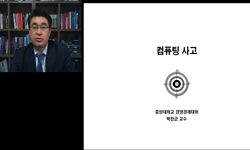The purpose of this study is to analyze the effects of nuclear power plant workers and organizational characteristics on accidents, and seek the combination of policies for reducing accidents. For this purpose, it grasped, by using System Dynamics and...
http://chineseinput.net/에서 pinyin(병음)방식으로 중국어를 변환할 수 있습니다.
변환된 중국어를 복사하여 사용하시면 됩니다.
- 中文 을 입력하시려면 zhongwen을 입력하시고 space를누르시면됩니다.
- 北京 을 입력하시려면 beijing을 입력하시고 space를 누르시면 됩니다.

원전 종사자 및 조직 특성이 사고에 미치는 영향 = A Study on the Effects of Nuclear Power Plant Workers and Organizational Characteristics on Accidents
한글로보기https://www.riss.kr/link?id=A100068314
- 저자
- 발행기관
- 학술지명
- 권호사항
-
발행연도
2014
-
작성언어
Korean
-
주제어
원전 ; 종사자 및 조직 ; 사고 ; 안전문화 ; 시스템다이내믹스 ; Nuclear Power Plant ; Employee and Organizational ; Accident ; Safety Culture ; System Dynamics
-
등재정보
KCI등재
-
자료형태
학술저널
- 발행기관 URL
-
수록면
5-25(21쪽)
-
KCI 피인용횟수
1
- 제공처
-
0
상세조회 -
0
다운로드
부가정보
다국어 초록 (Multilingual Abstract)
The purpose of this study is to analyze the effects of nuclear power plant workers and organizational characteristics on accidents, and seek the combination of policies for reducing accidents. For this purpose, it grasped, by using System Dynamics and Causal Loop Diagram, how various factors that cause accidents in nuclear plants are interrelated, and performed simulations after building simulation models. As a result of the analysis, first, the fundamental cause of safety accidents in nuclear power plants turned out to be the time constraint on the workload. Second, it turned out that as the workload of workers increases, physical and mental stresses increase, thereby increasing accidents due to errors and violations. Third, it turned out that as the levels of educational training and compliance with regulations and procedures are enhanced, accidents are reduced. Lastly, it turned out that as the combination of policies (reliance level + working environment + educational training + compliance with regulations and procedures) is increased, accidents are reduced. Especially, it turned out that if the combination of policies is increased by 30%, more than 10 cases of accidents are reduced.
참고문헌 (Reference)
1 교통안전공단, "항공안전문화지수 개발 및 적용방안 연구" 2008
2 한진환, "학습조직의 영향요인과 조직유효성에 관한 연구" 한국콘텐츠학회 6 (6): 42-49, 2006
3 조창현, "준정부조직의 기관유형별 학습조직 특성에 관한 실증분석: 탈관료제의 맥락에서" 한국행정연구소 49 (49): 63-92, 2011
4 윤영채, "준공공부문의 조직문화분석: 원자력발전소를 중심으로" 한국공공관리학회 26 (26): 27-54, 2012
5 제무성, "조직의 안전문화(Safety Culture)가 안전성에 미치는 영향연구" 2000
6 주상윤, "인적과오가 가스산업안전에 미치는 영향에 관한 연구" 울산대학교 2007
7 차용진, "위험인식모형과 원자력위험 - 심리측정패러다임 검증 및 적용" 한국정책학회 21 (21): 285-312, 2012
8 한국전력연구원, "원전 주기적 안전성 평가기술 개발" 2004
9 차용진, "원자력위험인식 변화추세 및 정책적 함의:수도권 일반주민을 중심으로" 경인행정학회 12 (12): 1-20, 2012
10 김대호, "원자력발전소의 절차서 기반 업무에서 직무스트레스의 조직요인과 조직성향 분석" 대한인간공학회 25 (25): 77-83, 2006
1 교통안전공단, "항공안전문화지수 개발 및 적용방안 연구" 2008
2 한진환, "학습조직의 영향요인과 조직유효성에 관한 연구" 한국콘텐츠학회 6 (6): 42-49, 2006
3 조창현, "준정부조직의 기관유형별 학습조직 특성에 관한 실증분석: 탈관료제의 맥락에서" 한국행정연구소 49 (49): 63-92, 2011
4 윤영채, "준공공부문의 조직문화분석: 원자력발전소를 중심으로" 한국공공관리학회 26 (26): 27-54, 2012
5 제무성, "조직의 안전문화(Safety Culture)가 안전성에 미치는 영향연구" 2000
6 주상윤, "인적과오가 가스산업안전에 미치는 영향에 관한 연구" 울산대학교 2007
7 차용진, "위험인식모형과 원자력위험 - 심리측정패러다임 검증 및 적용" 한국정책학회 21 (21): 285-312, 2012
8 한국전력연구원, "원전 주기적 안전성 평가기술 개발" 2004
9 차용진, "원자력위험인식 변화추세 및 정책적 함의:수도권 일반주민을 중심으로" 경인행정학회 12 (12): 1-20, 2012
10 김대호, "원자력발전소의 절차서 기반 업무에서 직무스트레스의 조직요인과 조직성향 분석" 대한인간공학회 25 (25): 77-83, 2006
11 김대호, "원자력발전소 조직의 성향과 종사자의 조직적합도 및 직무만족/몰입" 한국안전학회 21 (21): 77-83, 2006
12 김영갑, "원자력발전소 조직문화와 리더십과의 상관관계 분석" 2010
13 유재국, "원자력 발전소의 조직 및 인적인자 영향관계 모델개발" 2 (2): 65-83, 2001
14 안남성, "시스템다이내믹스를 활용한 원전 조직 및 인적인자 평가" 3 (3): 49-68, 2002
15 김도훈, "시스템다이내믹스" 대영문화사 1999
16 나병선, "대기업집단의 학습조직과 조직문화, 조직학습, 조직유효성의 관계분석" 고려대학교 대학원 2002
17 김사길, "국내 원전 불시정지 사례의 인적오류 위험요소(hazards) 분석보고서" 한국원자력연구원 2012
18 안남성, "국가에너지 이슈와 원자력의 역할" 2013
19 이상철, "공공기관의 조직문화, 학습조직, 조직효과성의 관계에 관한 연구" 한국행정학회 46 (46): 181-205, 2012
20 이용희, "가동 중 원자력발전소의 인적 오류 예방 기술 개발" 대한인간공학회 30 (30): 75-86, 2011
21 金明衡, "組織學習能力과 組織學習成果에 關한 硏究" 고려대학교 1996
22 Nevis, E. C., "Understanding organizations as learning systems" 36 (36): 73-85, 1995
23 Institute of Nuclear Power Operations, "Traits of a Healthy Nuclear Safety Culture" 2013
24 Schein, E. H., "Three culture of management: Key to organizational learning" 38 (38): 9-20, 1985
25 Goldberg, A. I., "Threat perception and the readiness to participate in safety programs" 12 (12): 10-122, 1991
26 Pedler, M., "The learning company: A strategy for sustainable development" McGraw-Hill 1991
27 Senge, P. M., "The fifth Discipline: The Art and Practice of The Learning Organization" Doubleday/Currency 1990
28 Yang, B., "The construct of the learning organization: dimensions, measurement, and validation" 15 (15): 31-55, 2004
29 Blake, R., "The Managerial Grid: The Key to Leadership Excellence" Gulf Publishing 1964
30 김병석, "System Thinking Perspective on the Dynamic Relationship between Organizational Characteristics of Nuclear Safety Culture" 대한인간공학회 33 (33): 77-86, 2014
31 International Nuclear Safety Advisory Group, "Summary Report on the Post-accident Review Meeting on the Chernobyl Accident" 1986
32 Watkins, K. E., "Sculpting the learning organization" Jossey-Bass 1993
33 Nuclear Regulatory Commission, "Safety Culture Attributes Table." 2005
34 International Nuclear Safety Advisory Group, "Safety Culture" 1991
35 International Atomic Energy Agency, "Report of the EXPERT MISSION to review the station blackout event that happened at Kori 1 NPP on 9 February 2012 Republic of Korea" 2012
36 Huang, Y. H., "Quality of the execution of corporate safety policies and employee safety outcomes" 18 (18): 483-506, 2004
37 Hammer, W., "Product safety management and engineering" Prentice Hall 1980
38 Institute of Nuclear Power Operations, "Principles for a Strong Nuclear Safety Culture" 2004
39 Lyneis, John, "Preventing Accidents and Building a Culture of Safety: Insights from a Simulation Model. Working Paper" Composite Information Systems Laboratory, Sloan School of Management, Massachusetts Institute of Technology 2008
40 Fiol, C. M., "Organizational Learning" 10 (10): 1985
41 OECD, "Organizational Factors Identification and Assessment" 1998
42 Robbins, S. P., "Organization Behavior" Prentice Hall International Edition 1996
43 HSC., "Organising for Safety: Third report of the Human Factors Study Group of ACSNI (Advisory Committee on the Safety Nuclear Installations)" HSE Books 1993
44 International Atomic Energy Agency, "Operational Safety Performance Indicator for Nuclear Power Plants" 2000
45 Lundberg, J. G., "On Organizational Learning" 3 (3): 1989
46 Leveson, N. G., "Modeling, Analyzing and Engineering NASA’s Safety Culture: Phase 1Final Report" Massachusetts Institute of Technology 2005
47 Richardson, George P., "Introduction to System Dynamics Modeling with Dynamo" The MIT Press 1981
48 Heinrich, H. W., "Industrial accident prevention" McGraw-Hill 1980
49 Morgan, G., "Images of organization" SAGE Publications 2006
50 OECD, "Identification and Assessment of Organizational factors related to the safety of NPPs" 1999
51 Reason, J., "Human error" Cambridge University Press 1990
52 Gershon, R. R., "Hospital safety climate and its relationship with safe work practices and workplace exposure incidents" 28 (28): 211-221, 2000
53 Richardson, George P., "Feedback Thought in Social Science and System Theory" University of Pennsylvania Press 1991
54 Meadows, D. H., "Elements of the System Dynamics Method" The MIT Press 1980
55 Rudolph, J. W., "Disaster Dynamics: Understanding the role of quantity in organizational collapse" 47 (47): 1-30, 2002
56 Barling, J. C., "Development and test of a model linking safety-specific transformational leadership and occupational safety" 87 (87): 488-496, 2002
57 Marquardt, M., "Building the learning organization" McGraw-Hill 1996
58 Garvin, D. A., "Building a Learning Organization" 71 (71): 1993
59 Denison, D. R., "Bringing corporate culture to the bottom line" 5-22, 1984
60 International Atomic Energy Agency, "ASCOT Guidelines"
61 Zohar, "A group-level model of safety climate: testing the effect of group climate on microaccidents in manufacturing jobs" 85 (85): 587-596, 2000
62 환경운동연합, "2차 에너지기본계획 원전 증설에 대해 시민들은 어떻게 생각할까?" 2013
동일학술지(권/호) 다른 논문
-
- 한국시스템다이내믹스학회
- 오영민 ( Young Min Oh )
- 2014
- KCI등재
-
System Dynamics를 활용한 기본소득의 지역 영향성에 대한 연구: 보편적 현금급여와 현물에너지급여의 비교를 중심으로
- 한국시스템다이내믹스학회
- 최인수 ( In Su Choi )
- 2014
- KCI등재
-
시스템 사고에 기반한 「지역교육청 기능 및 조직개편」 정책의 문제 및 원인 분석
- 한국시스템다이내믹스학회
- 하정윤 ( Jung Youn Ha )
- 2014
- KCI등재
-
환노출과 환노출 완화 전략의 인과관계에 관한 탐색적 연구: 시스템 사고에 의한 접근
- 한국시스템다이내믹스학회
- 엄재근 ( Jae Gun Eom )
- 2014
- KCI등재
분석정보
인용정보 인용지수 설명보기
학술지 이력
| 연월일 | 이력구분 | 이력상세 | 등재구분 |
|---|---|---|---|
| 2026 | 평가예정 | 재인증평가 신청대상 (재인증) | |
| 2020-01-01 | 평가 | 등재학술지 유지 (재인증) |  |
| 2017-01-01 | 평가 | 등재학술지 유지 (계속평가) |  |
| 2013-01-01 | 평가 | 등재 1차 FAIL (등재유지) |  |
| 2010-01-01 | 평가 | 등재학술지 선정 (등재후보2차) |  |
| 2009-01-01 | 평가 | 등재후보 1차 PASS (등재후보1차) |  |
| 2008-01-01 | 평가 | 등재후보학술지 유지 (등재후보1차) |  |
| 2007-01-01 | 평가 | 등재후보학술지 유지 (등재후보1차) |  |
| 2005-06-29 | 학회명변경 | 한글명 : 한국시스템다이네믹스학회 -> 한국시스템다이내믹스학회영문명 : 미등록 -> Korean System Dynamics Society |  |
| 2005-01-01 | 평가 | 등재후보학술지 선정 (신규평가) |  |
학술지 인용정보
| 기준연도 | WOS-KCI 통합IF(2년) | KCIF(2년) | KCIF(3년) |
|---|---|---|---|
| 2016 | 0.55 | 0.55 | 0.55 |
| KCIF(4년) | KCIF(5년) | 중심성지수(3년) | 즉시성지수 |
| 0.56 | 0.48 | 0.599 | 0.39 |





 ScienceON
ScienceON KISS
KISS






